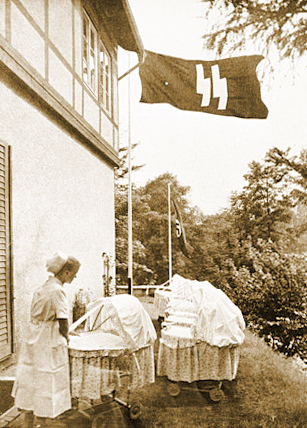Demographic crisis
Four years earlier, in December 1935, the entity that would be in charge of the project, Lebensborn—Source of Life—had been created: a social assistance organisation whose main purpose was to offer different types of facilities for single mothers and their babies.
The German population had been declining for decades, and the country was suffering a severe demographic crisis. The birth rate, which at the beginning of the century was 35.8 children per thousand inhabitants, had fallen to 14.7 in 1933, the year of Hitler’s rise to power. For the Führer’s ambition to populate the eastern regions with Aryans, it was essential to reverse this trend. Himmler estimated that 120 million people were needed.
Family life and motherhood were promoted in various ways, notably with special marriage loans and grants for each birth to encourage Germans to bring more children into the world. At the same time, any information on contraception was suppressed and contraceptives were banned. Abortion was also outlawed, which was labelled ‘sabotage against the future of Germany’.
The idea of increasing the population with a large number of children of the superior race was firmly rooted in the mentality of the party. ‘If Germany had a million children a year and eliminated between 700,000 and 800,000 of the weakest, the result would probably be an increase in its strength’, Hitler had affirmed with conviction at a party meeting in 1929.
Here it is worth interpolating vignettes from my own life.
Non-consanguineous relatives had a son who was born the same year I was born. But this guy is mentally retarded, so terribly retarded that he once bit off his sister’s finger. Another case: the only friend with whom I spoke disparagingly about the race of the country in which we were born had a Down syndrome sister whose retardation was so great that, if they left her a few meters outside her apartment, she wouldn’t know how to return home: a lower IQ than a dog.
These real-life cases show that one must be truly lobotomised through Christian ethics to avoid what the ancient Greeks and Romans did with their defective babies. It is more than obvious that Christianity has fried the brains of the white parents of these people I know, and millions of others like them.
Among my relatives, only Uncle Beto admired Hitler. He once said having in mind, I believe, one of my handicapped cousins: ‘I would kill such a daughter and then I would go to hell!’ He meant that he’d kill her if she was his daughter. Although I was not a witness of this anecdote I guess that his sisters, my great-aunts, were scandalised by these kinds of pronouncements.
But let’s continue with the Third Reich.
‘If we could establish the Nordic race from Germany and, from this seedbed, produce a race of 200 million, the world would be ours’, Himmler eloquently expressed. A few months after its founding, Lebensborn opened Heim Hochland, the first home for pregnant women. For this, the National Socialists took over the building of a Catholic orphanage located in the town of Munich.
Initially, the institution could host up to thirty mothers and fifty-five children, and applicants were carefully screened. Only women who had the characteristics of the dominant race were admitted. Candidates had their skull measured, and only those with the highly coveted elongated skull, typical of the Aryans, were eligible for admission. They also had to meet other requirements, such as being blonde, having blue or green eyes, and being in good health.
 Those who passed the test received the best care in exquisite surroundings as a reward. Homes were often in stately homes that, as in the case of Heim Hochland, had often been taken from Hitler’s enemies, and other mansions from Jews. The organisation’s headquarters in Munich was in a house that had been owned by the writer Thomas Mann, (who had six children with his Jewish wife). All homes were equipped with modern medical equipment and cared for by specialised medical personnel.
Those who passed the test received the best care in exquisite surroundings as a reward. Homes were often in stately homes that, as in the case of Heim Hochland, had often been taken from Hitler’s enemies, and other mansions from Jews. The organisation’s headquarters in Munich was in a house that had been owned by the writer Thomas Mann, (who had six children with his Jewish wife). All homes were equipped with modern medical equipment and cared for by specialised medical personnel.
These luxurious conditions had their effect. In 1939, Gregor Ebner, Lebensborn’s medical director, informed Himmler that a total of 1,300 women had applied. Of these, 635 had been considered suitable due to their racial characteristics and their state of health.
The births went very well. While in Germany the mortality of newborns was six percent, in the homes of the Lebensborn Organisation this figure was reduced by half. ‘Deliveries are easy, without major complications, which is attributable to the racial selection and quality of women we welcome’, Ebner wrote proudly. Logically, all this had a high cost: 400 marks per mother. ‘It is not a great sacrifice if we can save a million children with good blood’, Ebner concluded.